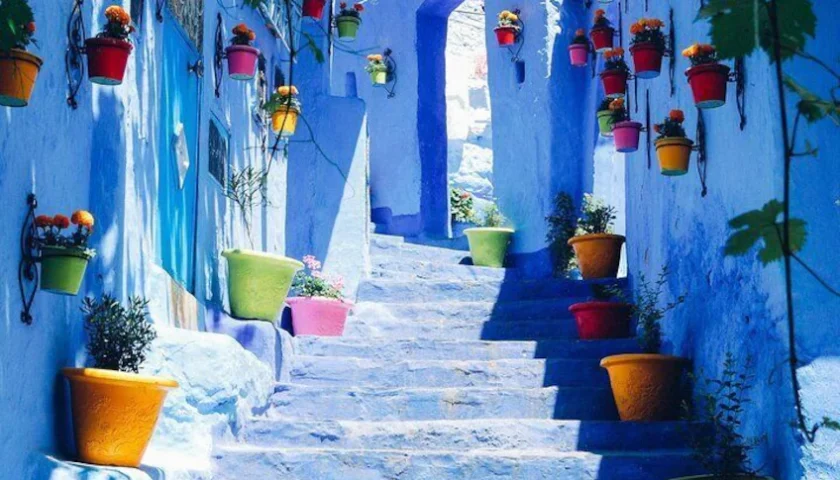Morocco Casablanca To Chefchaouen Tour is a fascinating country located at a stone’s throw from Europe and enjoying two seas, several impressive mountain ranges, a delicious cuisine and an amazing history. Its architecture, traditions, archaeological sites, religious buildings and souks are definitely worth a visit, so here are just a few of the innumerable sites whose visit is highly recommended.
1. Djemaa el Fna square in Marrakech
The Djemaa el Fna square, which dates from the 11th century, is the main square in Marrakech and the most famous place of the Ochre City. It is one of the largest and more animated squares in the world. Moreover, as pointed out by the Spanish writer Juan Goytisolo on his article Jemaa-el-Fna’s thousand and one nights, the square is “the only place on the planet where musicians, storytellers, dancers, jugglers and bards put on a new show before large crowds every day of the year”.
The square’s entertainments are innumerable and curious and include, among many others, snake charmers, henna tattooists, story tellers, fortune tellers, scribes, transvestite dancers, acrobats, marabouts or spiritual masters stating their teachings, street dentists, water sellers, Barbary apes tamers, all kinds of musicians and dancers, fairground attractions, magicians and traditional potions dealers.
2. Al-Karaouiyine Mosque and University in Fez
Al-Karaouiyine is one of the most important mosques and the oldest continuous operating university in the world. Its construction started in 857, but its architecture has evolved and grown throughout history until it became, in the 10th and 11th centuries, one of the most important educational centers and one of the first universities in the world. Several distinguished personalities studied there, such as the precursors of Sufism Ibn Hrizim, Abou Madyane or Abdeslam Ben Mchich Alami, the philosophers Avenpace and Averroès, the geographer Al Idrissi, as well as Maimonides and Ibn Khaldoun among many others.
The Al Karaouine mosque is nowadays the largest mosque in North Africa and it can hold more than 20.000 worshippers. Its design is rather austere, with plain white columns and arches and floors covered with reed mats instead of lush carpets. The mosque has 270 columns making 16 naves of 21 arches each, a sight that evokes a majestic and intimate forest of arches, in contrast with the simplicity of the design compliments the finely decorated niches, pulpit and outer courtyard.
3. Volubilis
Volubilis is an ancient Roman city located on the banks of the wadi Khoumane, near the imperial city of Meknes, and listed as a UNESCO World Heritage Site. The city lived on the trade of olive oil, which is indicated by the many remains of olive-presses among the ruins. The most spectacular remains are a great number of mosaics decorating the floors of rich residences. But their preservation is quite problematic, since they are exposed to the sun, the wind and the visitors, who can trample around freely.
In 1946, the excavations unearthed several bronze busts, one of which was that of Cato of Utica. Other remains of the Roman town have been uncovered. Such as what should probably be interpreted as the headquarters of Idris I just below the walls of the Roman town to the west. In certain houses the plan of these grand residences can be seen, with their atrium and their impluvium. As well as certain bathing establishments, particularly four from Roman times with hypocaust (system of central heating) and a hammam from the Arab period.
4. Hassan II Mosque in Casablanca
The Hassan II Mosque of Casablanca was planned on the spot of the old municipal swimming pool. Its construction started on the 12th July 1986 and was inaugurated on the 30th August 1993. It is the world’s third largest mosque (after Mecca’s and Medina’s), with an inner court that can accommodate up to 120.000 worshippers and a prayer room welcoming up to 25.000.
The mosque was built right by the sea and its minaret is 210 meters (680 ft.) high. Which makes of the mosque the world’s tallest religious building. It was designed by the French architect Michel Pinseau and built by Morocco’s best craftsmen recruited around the entire kingdom. Overall, they sculpted 53.000 square meters of wood and painted more than 10.000 square meters of ceramics. Authorities spent an estimated EUR575 million in the construction of the building.
5. Chefchaouen
Chefchaouen is a city located in the Rif Mountains, in Northern Morocco Guided Tour. Just inland from Tangiers and Tetouan and almost 2000 feet above sea level. Its name means “the horns” in Berber language in reference to the two main mountain summits that dominate and surround the city. It was founded in 1471 as a fortress to protect its population from the Portuguese and Spanish conquest after the Spanish Reconquista.
Chefchaouen is an enormously popular tourist destination, where over 200 hotels can accommodate the mostly European summer visitors who come to admire its blue-rinsed houses and buildings. A tradition that comes from the town’s former Jewish population. This charming city also offers excellent shopping opportunities. Especially native handicrafts typical to the region, such as wool garments and woven blankets, as well as some gastronomic delicacies.

